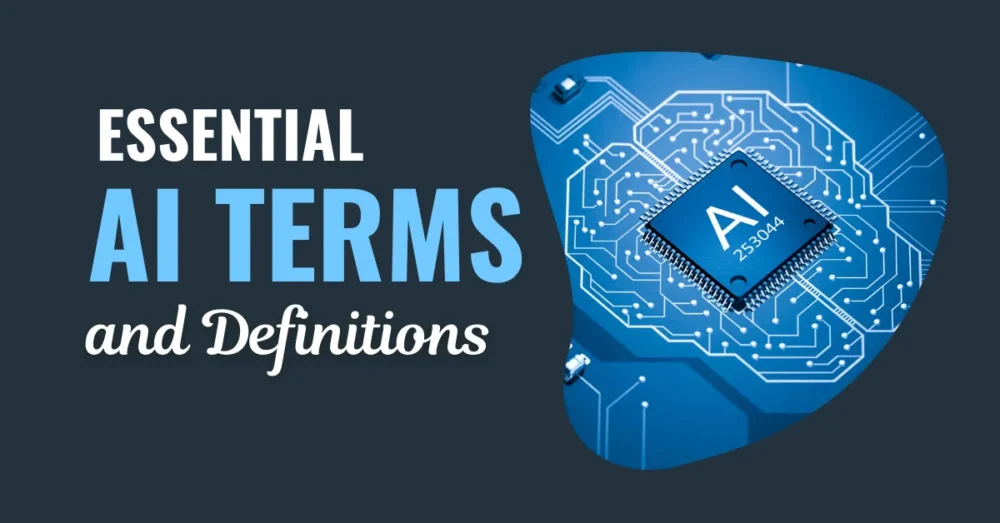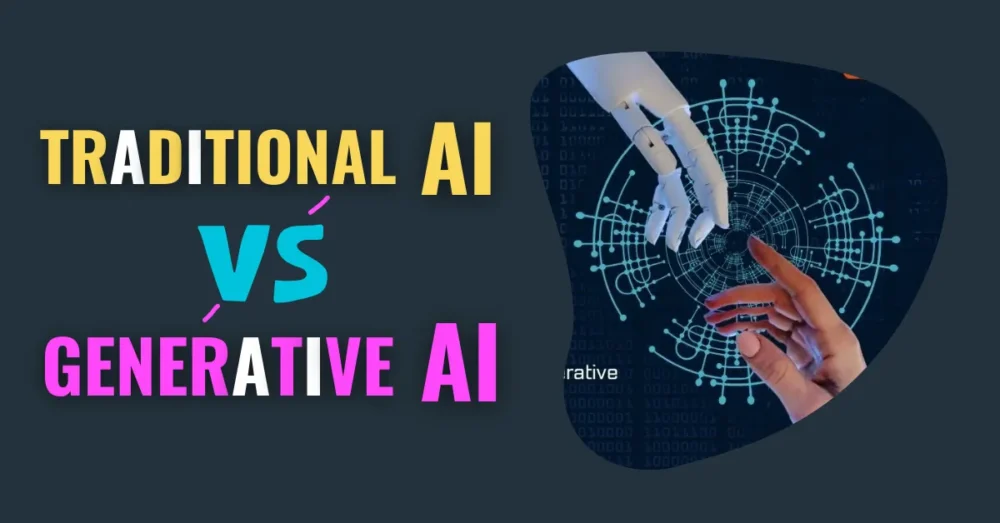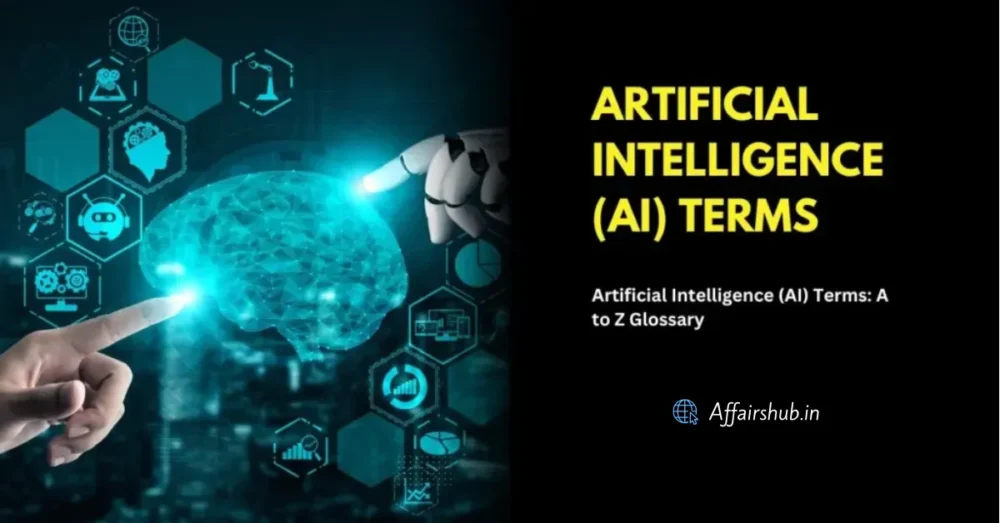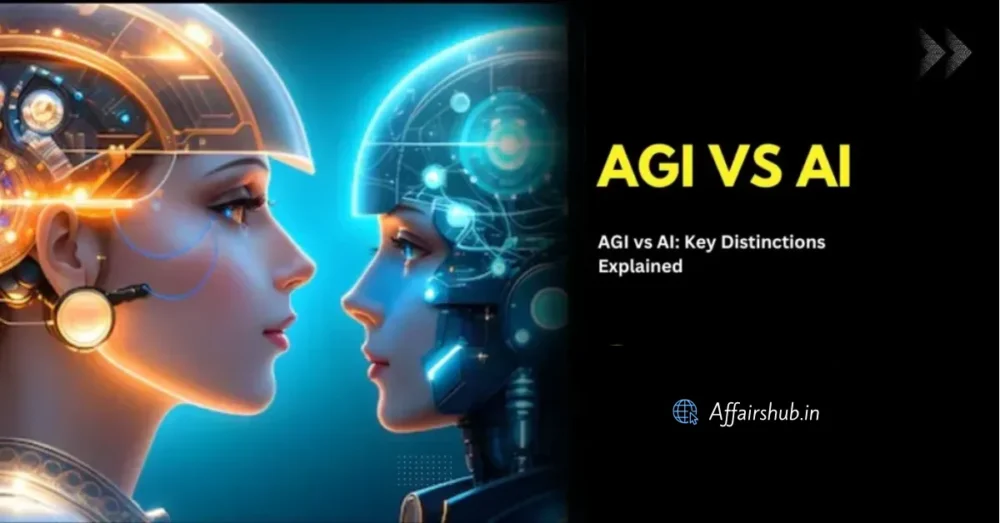Hey, exam warriors! Preparing for your competitive exams? Let’s talk about something cool and super important: AI! You’ve probably heard of it, but do you know the difference between Traditional AI and Generative AI? Don’t worry, we’re here to explain it in a simple way.
◾Also Explore: Artificial Intelligence (AI) Terms: A to Z Glossary 2024
Traditional AI: The Problem Solver
- Traditional AI is like the smart older sibling who excels at solving problems.
- It works by studying past data, understanding patterns, and applying them to find solutions.
- Think of it as a student who studies past exam papers to answer questions perfectly.
- It’s great for tasks like solving math problems, predicting the weather, or analyzing data.
- Key Feature: Traditional AI focuses on learning from existing data and providing accurate answers.
Generative AI: The Creative Genius
- Generative AI is like the younger sibling who is super creative and imaginative.
- Instead of just solving problems, it creates new things based on what it has learned.
- It can write a poem in Mirza Ghalib’s style or compose a melody inspired by Tansen.
- Generative AI uses data as inspiration to generate fresh and unique content.
- Key Feature: Generative AI focuses on innovation and creation, making something completely new.
Key Difference
- Traditional AI: Studies data, solves problems, and predicts outcomes—like a textbook wizard!
- Generative AI: Creates new ideas, content, or solutions—like an artistic genius!
So, while Traditional AI is great at following rules and finding answers, Generative AI is all about thinking outside the box and making something new. Isn’t that amazing?
Importance of Generative AI in Learning
Generative AI is a game-changer, especially for students and learners aiming to become the next Einsteins or Kalpana Chawlas. Here’s why understanding and using Generative AI can transform your learning experience:
1. Boost Your Study Skills
- Generative AI can create personalized learning plans tailored to your strengths and weaknesses.
- Imagine an AI tutor that explains tough concepts in the style of your favorite teacher, making learning more engaging and fun.
- It can even suggest customized study materials to help you focus on areas where you need improvement.
2. Excel in Creative Writing
- Need help writing an essay, story, or poem? Generative AI can provide unique ideas and assist in crafting content that stands out.
- Whether it’s an emotional poem or a thought-provoking essay, AI can make the process easier and more creative.
3. Enhance Your Research Skills
- Generative AI can analyze large datasets quickly, helping you explore new research questions or ideas you may not have considered.
- It can summarize information, create connections between topics, and even propose innovative solutions, making it an essential tool for groundbreaking discoveries.
4. Make Learning Interactive
- AI-powered tools can simulate real-world scenarios or create interactive quizzes to make your studies more engaging.
- From solving math problems to exploring scientific concepts, Generative AI turns learning into an exciting journey.
Final Thought
Now that you know how Generative AI can boost creativity, enhance study skills, and open new research possibilities, it’s time to dive deeper into the workings of both Traditional AI and Generative AI. Understanding which one suits your learning needs best will help you use these powerful tools to ace your studies.
What is Traditional AI?
Traditional AI, also called Weak AI or Narrow AI, is like a skilled expert focused on specific tasks. It’s incredibly good at what it’s trained to do, but it doesn’t have the flexibility to handle tasks beyond its programming.
Understanding Traditional AI
Imagine a chess grandmaster:
- It analyzes the board, predicts the opponent’s moves, and plans brilliant strategies.
- Similarly, Traditional AI uses data and algorithms to perform specific tasks with precision.
But here’s the catch—it can’t learn new things or adapt to unfamiliar situations.
What Can Traditional AI Do?
Traditional AI shines in many fields by solving problems with speed and accuracy. Here are some real-world examples:
- Playing Games: It can master chess, Go, and even complex video games by analyzing patterns and predicting outcomes.
- Medical Diagnoses: AI can examine medical scans and patient data to detect diseases with remarkable accuracy.
- Language Translation: Breaking down language barriers, AI-powered tools like Google Translate help translate text and speech effectively.
Limitations of Traditional AI
While Traditional AI is impressive, it’s not a jack-of-all-trades. Here’s why:
- It works only within its programming and training data.
- Unlike General AI, it can’t think creatively or adapt to new challenges.
- Think of Siri or Alexa: They can play music or answer simple questions but can’t solve complex problems or create something new.
Everyday Applications of Traditional AI
Traditional AI is all around us, making life easier in many ways:
- Spam Filters: AI identifies and blocks suspicious emails, keeping your inbox clean.
- Personalized Recommendations: Platforms like Netflix and Amazon use AI to suggest movies, books, or products you might like.
- Fraud Detection: Banks rely on AI to detect unusual financial activity and protect your money.
The Bottom Line: A Powerful, But Limited Tool
Traditional AI is a valuable tool for specific tasks, but it’s not a substitute for human creativity, critical thinking, or adaptability. It’s like having a highly skilled assistant who excels in their field but can’t go beyond what they’ve learned.
How Does Traditional AI Work?
Traditional AI, the data-driven genius, operates by identifying patterns, analyzing information, and solving specific problems. Let’s break it down with an example:
Remember the chess-playing computer that defeated Garry Kasparov? That’s traditional AI at work!
How It Learns
Think of Traditional AI as a super detective in training:
- It’s shown tons of evidence, like photos, X-rays, or customer reviews.
- It learns to spot patterns and uses this knowledge to solve mysteries or perform tasks.
What Traditional AI Can Do
Traditional AI is great at using what it’s learned to:
- Make Predictions:
- Will this X-ray reveal pneumonia?
- Would this customer enjoy a specific movie?
- Make Decisions:
- Should a loan application be approved?
- What’s the safest route for a self-driving car?
- Generate Outputs:
- Translate a website into another language.
- Write a summary or article based on collected data.
Key Types of Traditional AI
Here are some popular “AI detectives” that power its capabilities:
- Expert Systems:
- These act like AI doctors, analyzing symptoms to suggest diagnoses.
- Example: Medical diagnostic systems in hospitals.
- Decision Trees:
- Like a flowchart, they analyze factors (like credit scores) to make decisions, such as approving or denying loans.
- Natural Language Processing (NLP):
- This multilingual detective deciphers human speech and text.
- Example: AI tools like Google Translate or chatbots.
Limitations of Traditional AI
While Traditional AI is impressive, it’s built for specific tasks:
- It’s like a chess champion—brilliant at chess but useless in composing a symphony.
- It relies heavily on pre-existing data and can’t tackle problems outside its trained domain.
Everyday Examples of Traditional AI
You encounter Traditional AI in action more often than you realize:
- Google Translate: Breaking language barriers with real-time translations.
- Amazon Recommendations: Suggesting products based on browsing history.
- Spam Filters: Keeping junk emails out of your inbox.
So next time you see a product recommendation or use a translator app, think of the hardworking AI detectives behind the scenes, making decisions faster and more accurately than humans!
For those unfamiliar with Van Gogh, consider reading the articles on FORBES: AI-Powered Van Gogh
What is Generative AI?
Generative AI is like an artist with unlimited imagination, using data as its canvas to create something entirely new. If Traditional AI is the problem-solving detective, Generative AI is the fearless creator, blending creativity with technology to reimagine possibilities.
Generative AI in Action
Imagine:
- Singing like Arijit Singh,
- Creating art inspired by M.F. Husain,
- Delivering speeches with the flair of Narendra Modi—
That’s the magic of Generative AI! Unlike traditional AI, which follows set rules, generative AI dreams up fresh ideas, crafting text, images, music, and even new inventions.
How Is Generative AI Different?
Here’s a comparison to understand the key difference:
- Traditional AI: Plays chess flawlessly but follows fixed rules.
- Generative AI: Redefines the chessboard, inventing new moves and strategies that have never been seen before.
This creativity is powered by its ability to learn from massive amounts of data, uncover patterns, and generate outputs that feel original and human-like.
What Can Generative AI Create?
- Text: From poems and stories to emails and code, it’s your creative writing assistant.
- Images: Stunning artworks, realistic photos, and unique visual designs.
- Audio: AI-composed songs, symphonies, or even lifelike voiceovers.
- Videos: Animations or cinematic creations generated with AI.
Real-World Applications
Generative AI is already transforming industries in remarkable ways:
- Drug Discovery: Designing new molecules to develop life-saving medicines faster.
- Fashion Design: Generating unique patterns and predicting upcoming trends.
- Product Innovation: Optimizing product shapes, materials, and designs for better usability.
- Education: Personalized study materials and tools to help students learn creatively.
The Future of Generative AI
Generative AI is still evolving, but its potential is enormous. While it won’t replace human creativity, it acts as a powerful tool to:
- Enhance imagination: Helping creators brainstorm unique ideas.
- Speed up processes: Transforming industries with quicker innovations.
The next big AI-powered creation might surprise and inspire you, so keep watching this exciting space!
Which Type of AI is Best for Education?
Choosing the right type of AI for education depends on the specific goals educators or students want to achieve. Both Traditional AI and Generative AI have distinct advantages and applications in education, often complementing one another to create an enriched learning experience.
How Traditional AI Benefits Education
- Personalized Learning
- Analyzes student performance to recommend tailored study materials.
- Offers adaptive learning paths to help struggling learners catch up.
- Automated Grading and Feedback
- Speeds up tasks like grading quizzes and assignments.
- Provides instant feedback, freeing teachers to focus on deeper learning strategies.
- Virtual Assistants and Tutors
- AI chatbots help answer common questions and provide extra practice.
- Intelligent tutoring systems guide students through challenging topics.
- Data Analysis for Better Insights
- Identifies trends and predicts student outcomes.
- Informs curriculum planning and resource allocation.
How Generative AI Transforms Education
- Content Creation and Customization
- Generates personalized study materials, such as adaptive textbooks or quizzes.
- Creates engaging exercises based on students’ interests.
- Immersive Learning Experiences
- Designs virtual reality (VR) simulations and gamified learning environments.
- Enhances understanding through interactive, hands-on experiences.
- Boosting Creativity and Critical Thinking
- Assists in brainstorming, essay writing, and analyzing data.
- Encourages students to solve problems creatively.
- Accessibility and Inclusivity
- Provides text-to-speech, language translation, and captioning tools.
- Supports students with disabilities or those learning in a second language.
When to Use Generative AI?
Generative AI is particularly beneficial for:
- Competitive exam prep: Summarizing chapters, solving doubts, and generating quick study notes.
- Creative writing tasks: Generating essay ideas, drafting letters, or creating unique stories.
- Learning English: Simplifying grammar rules, enhancing vocabulary, and practicing language skills.
Popular tools like ChatGPT or Google Bard are excellent for these tasks, offering quick, personalized assistance.
Factors to Consider When Choosing AI for Education
- Technology Maturity
- Traditional AI is well-established and reliable for structured tasks.
- Generative AI, while innovative, is still developing and may struggle with complex problems like advanced math or logic puzzles.
- Ethical Concerns
- AI tools must avoid biases and promote inclusivity.
- Educators should monitor content to ensure fairness and avoid harmful stereotypes.
- Cost and Accessibility
- Advanced tools, such as GPT-4 (used in ChatGPT Plus), often require subscriptions (e.g., $20/month), which may not be affordable for all students or schools.
Blending Both Types of AI for Better Outcomes
A hybrid approach that leverages both traditional and generative AI offers the most comprehensive solution:
- Use Traditional AI for structured, repetitive tasks like grading and performance analysis.
- Employ Generative AI for creative tasks, immersive learning, and personalized support.
Final Note: AI Is a Tool, Not a Replacement
While AI can significantly enhance education, the human touch of educators remains irreplaceable. Teachers bring empathy, experience, and adaptability that no machine can replicate. Together, AI and educators can create a nurturing and impactful learning environment for students of all ages.
How Generative AI Differs from Traditional AI: A Quick Comparison
| Feature | Traditional AI (Weak AI) | Generative AI (Strong AI) |
|---|---|---|
| Focus | Analyzing data, solving problems, predicting outcomes | Highly accurate within the trained domain, efficient at repetitive tasks |
| Underlying Technology | Machine learning algorithms based on existing data | Machine learning and probabilistic models for generating new data |
| Capabilities | Performs specific tasks within predefined rules | Creates original content, adapts to new situations, learns through experimentation |
| Examples | Spam filters, chess-playing programs, medical diagnosis systems | Chatbots, image generators, music composers, writing assistants |
| Strengths | Highly accurate within trained domain, efficient at repetitive tasks | Innovative, versatile, promotes creativity and exploration |
| Weaknesses | Limited to pre-defined rules, lacks adaptability, can’t generate new ideas | Still under development, can be prone to errors and biases, requires large amounts of data |
| Applications | Finance, healthcare, manufacturing, logistics | Music, art, design, marketing, education, research |
Final Word
The future of AI is bright, and understanding its different aspects like Traditional and Generative AI will give you a competitive edge in your studies and future careers. So, keep learning, keep innovating, and remember, the only limit is your imagination!






